Many to Many Relationship with ABP and EF Core
Introduction
In this article, we'll create a BookStore application like in the ABP tutorial and add an extra Category feature to demonstrate how we can manage the many-to-many relationship with ABP-based applications (by following DDD rules).
You can see the ER Diagram of our application below. This diagram will be helpful for us to demonstrate the relations between our entities.
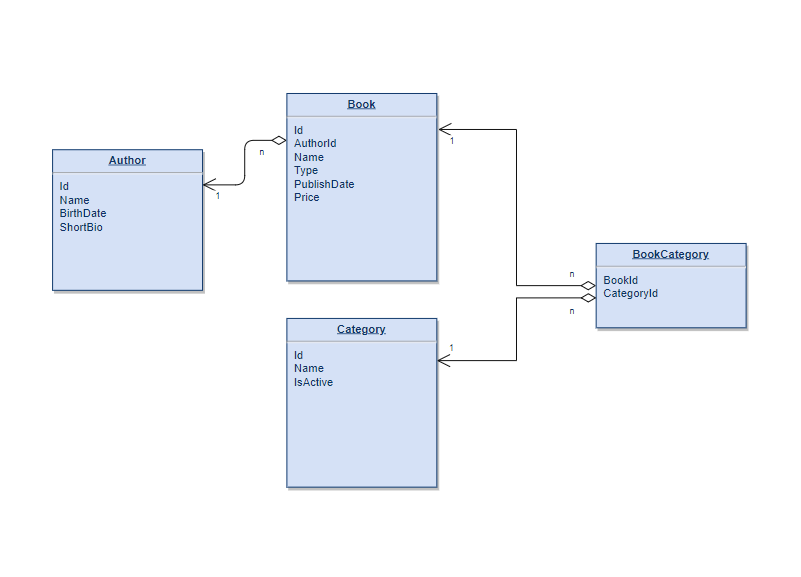
When we've examined the ER Diagram, we can see the one-to-many relationship between the Author and the Book tables. Also, the many-to-many relationship (BookCategory table) between the Book and the Category tables. (There can be more than one category on each book and vice-versa in our scenario).
🛠 Liked this post? I now share all my content on Substack — real-world .NET, AI, and scalable software design.
👉 Subscribe here → engincanveske.substack.com
🎥 Also, check out my YouTube channel for hands-on demos and deep dives: https://www.youtube.com/@engincanv
Source Code
You can find the source code of the application at https://github.com/EngincanV/ABP-Many-to-Many-Relationship-Demo .
Demo of the Final Application
At the end of this article, we will have created an application same as in the gif below.

Creating the Solution
In this article, we will create a new startup template with EF Core as a database provider and MVC for UI framework.
- We can create a new startup template by using the ABP CLI:
abp new BookStore -t app --version 5.0.0-beta.2
- Our project boilerplate will be ready after the download is finished. Then, we can open the solution and start developing.
Starting the Development
Let's start with creating our Domain Entities.
Step 1 - (Creating the Domain Entities)
We can create a folder-structure under the BookStore.Domain project like in the image below.
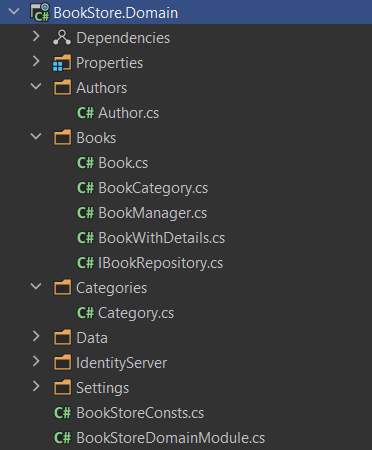
Open the entity classes and add the following codes to each of these classes.
- Author.cs
using System;
using JetBrains.Annotations;
using Volo.Abp;
using Volo.Abp.Domain.Entities.Auditing;
namespace BookStore.Authors
{
public class Author : FullAuditedAggregateRoot<Guid>
{
public string Name { get; private set; }
public DateTime BirthDate { get; set; }
public string ShortBio { get; set; }
/* This constructor is for deserialization / ORM purpose */
private Author()
{
}
public Author(Guid id, [NotNull] string name, DateTime birthDate, [CanBeNull] string shortBio = null)
: base(id)
{
SetName(name);
BirthDate = birthDate;
ShortBio = shortBio;
}
public void SetName([NotNull] string name)
{
Name = Check.NotNullOrWhiteSpace(
name,
nameof(name),
maxLength: AuthorConsts.MaxNameLength
);
}
}
}
We'll create the
AuthorConstsclass later in this step.
- Book.cs
using System;
using System.Collections.Generic;
using System.Collections.ObjectModel;
using System.Linq;
using Volo.Abp;
using Volo.Abp.Domain.Entities.Auditing;
namespace BookStore.Books
{
public class Book : FullAuditedAggregateRoot<Guid>
{
public Guid AuthorId { get; set; }
public string Name { get; private set; }
public DateTime PublishDate { get; set; }
public float Price { get; set; }
public ICollection<BookCategory> Categories { get; private set; }
private Book()
{
}
public Book(Guid id, Guid authorId, string name, DateTime publishDate, float price)
: base(id)
{
AuthorId = authorId;
SetName(name);
PublishDate = publishDate;
Price = price;
Categories = new Collection<BookCategory>();
}
public void SetName(string name)
{
Name = Check.NotNullOrWhiteSpace(name, nameof(name), BookConsts.MaxNameLength);
}
public void AddCategory(Guid categoryId)
{
Check.NotNull(categoryId, nameof(categoryId));
if (IsInCategory(categoryId))
{
return;
}
Categories.Add(new BookCategory(bookId: Id, categoryId));
}
public void RemoveCategory(Guid categoryId)
{
Check.NotNull(categoryId, nameof(categoryId));
if (!IsInCategory(categoryId))
{
return;
}
Categories.RemoveAll(x => x.CategoryId == categoryId);
}
public void RemoveAllCategoriesExceptGivenIds(List<Guid> categoryIds)
{
Check.NotNullOrEmpty(categoryIds, nameof(categoryIds));
Categories.RemoveAll(x => !categoryIds.Contains(x.CategoryId));
}
public void RemoveAllCategories()
{
Categories.RemoveAll(x => x.BookId == Id);
}
private bool IsInCategory(Guid categoryId)
{
return Categories.Any(x => x.CategoryId == categoryId);
}
}
}
In our scenario, a book can have more than one category and a category can have more than one book so we need to create a many-to-many relationship between them.
For achieving this, we will create a join entity named
BookCategory, and this class will simply have variables namedBookIdandCategoryId.To manage this join entity, we can add it as a sub-collection to the Book entity, as we do above. We add this sub-collection
to Book class instead of Category class, because a book can have tens (or mostly hundreds) of categories but on the other perspective a category can have more than a hundred (or even way much) books inside of it.It is a significant performance problem to load thousands of items whenever you query a category. Therefore it makes much more sense to add that sub-collection to the
Bookentity.
Don't forget: Aggregate is a pattern in Domain-Driven Design. A DDD aggregate is a cluster of domain objects that can be treated as a single unit. (See the full description)
Notice that,
BookCategoryis not an Aggregate Root so we are not violating one of the base rules about Aggregate Root (Rule: "Reference Other Aggregates Only by ID").If we examine the methods in the
Bookclass (such as RemoveAllCategories, RemoveAllCategoriesExceptGivenIds and AddCategory) we will manage our sub-collectionCategories(BookCategory - join table/entity) through them. (Adds or removes categories for books)
We'll create the
BookCategoryandBookConstsclasses later in this step.
- BookCategory.cs
using System;
using Volo.Abp.Domain.Entities;
namespace BookStore.Books
{
public class BookCategory : Entity
{
public Guid BookId { get; protected set; }
public Guid CategoryId { get; protected set; }
/* This constructor is for deserialization / ORM purpose */
private BookCategory()
{
}
public BookCategory(Guid bookId, Guid categoryId)
{
BookId = bookId;
CategoryId = categoryId;
}
public override object[] GetKeys()
{
return new object[] {BookId, CategoryId};
}
}
}
Here, as you can notice, we've defined the
BookCategoryas the Join Table/Entity for our many-to-many relationship and ensured the required properties (BookId and CategoryId) were set in the constructor method of this class to create this object.And also we've derived this class from the
Entityclass and therefore we've had to override the GetKeys method of this class to define the Composite Key.
The composite key is composed of
BookIdandCategoryIdin our case. And they are unique together.
For more information about Entities with Composite Keys, you can read the relevant section from Entities documentation.
- BookManager.cs
using System;
using System.Linq;
using System.Threading.Tasks;
using BookStore.Categories;
using JetBrains.Annotations;
using Volo.Abp.Domain.Repositories;
using Volo.Abp.Domain.Services;
namespace BookStore.Books
{
public class BookManager : DomainService
{
private readonly IBookRepository _bookRepository;
private readonly IRepository<Category, Guid> _categoryRepository;
public BookManager(IBookRepository bookRepository, IRepository<Category, Guid> categoryRepository)
{
_bookRepository = bookRepository;
_categoryRepository = categoryRepository;
}
public async Task CreateAsync(Guid authorId, string name, DateTime publishDate, float price, [CanBeNull]string[] categoryNames)
{
var book = new Book(GuidGenerator.Create(), authorId, name, publishDate, price);
await SetCategoriesAsync(book, categoryNames);
await _bookRepository.InsertAsync(book);
}
public async Task UpdateAsync(
Book book,
Guid authorId,
string name,
DateTime publishDate,
float price,
[CanBeNull] string[] categoryNames
)
{
book.AuthorId = authorId;
book.SetName(name);
book.PublishDate = publishDate;
book.Price = price;
await SetCategoriesAsync(book, categoryNames);
await _bookRepository.UpdateAsync(book);
}
private async Task SetCategoriesAsync(Book book, [CanBeNull] string[] categoryNames)
{
if (categoryNames == null || !categoryNames.Any())
{
book.RemoveAllCategories();
return;
}
var query = (await _categoryRepository.GetQueryableAsync())
.Where(x => categoryNames.Contains(x.Name))
.Select(x => x.Id)
.Distinct();
var categoryIds = await AsyncExecuter.ToListAsync(query);
if (!categoryIds.Any())
{
return;
}
book.RemoveAllCategoriesExceptGivenIds(categoryIds);
foreach (var categoryId in categoryIds)
{
book.AddCategory(categoryId);
}
}
}
}
If we examine the codes in the
BookManagerclass, we can see that we've managed theBookCategoryclass (our join table/entity) by using some methods that we've defined in theBookclass such as RemoveAllCategories, RemoveAllCategoriesExceptGivenIds and AddCategory.These methods basically add or remove categories related to the book by conditions.
In the
CreateAsyncmethod, if the category names are specified, we'll retrieve their ids from the database and by using the AddCategory method that we've defined in theBookclass, we'll add them.In the
UpdateAsyncmethod, the same logic is also valid. But in this case, the user might want to remove some categories from books, so if the user sends us an empty categoryNames array, we remove all categories from the book he wants to update. If the user sends us some category names, we remove the excluded ones and add the new ones according to the categoryNames array.BookWithDetails.cs
using System;
using Volo.Abp.Auditing;
namespace BookStore.Books
{
public class BookWithDetails : IHasCreationTime
{
public Guid Id { get; set; }
public string Name { get; set; }
public DateTime PublishDate { get; set; }
public float Price { get; set; }
public string AuthorName { get; set; }
public string[] CategoryNames { get; set; }
public DateTime CreationTime { get; set; }
}
}
We will use this class to retrieve books with their sub-categories and author names.
- IBookRepository.cs
using System;
using System.Collections.Generic;
using System.Threading;
using System.Threading.Tasks;
using Volo.Abp.Domain.Repositories;
namespace BookStore.Books
{
public interface IBookRepository : IRepository<Book, Guid>
{
Task<List<BookWithDetails>> GetListAsync(
string sorting,
int skipCount,
int maxResultCount,
CancellationToken cancellationToken = default
);
Task<BookWithDetails> GetAsync(Guid id, CancellationToken cancellationToken = default);
}
}
We need to create two methods named GetListAsync and GetAsync and specify their return type as BookWithDetails. So by implementing these methods, we will return the book/books by their details (author name and categories).
- Category.cs
using System;
using Volo.Abp;
using Volo.Abp.Domain.Entities.Auditing;
namespace BookStore.Categories
{
public class Category : AuditedAggregateRoot<Guid>
{
public string Name { get; private set; }
/* This constructor is for deserialization / ORM purpose */
private Category()
{
}
public Category(Guid id, string name) : base(id)
{
SetName(name);
}
public Category SetName(string name)
{
Name = Check.NotNullOrWhiteSpace(name, nameof(name), CategoryConsts.MaxNameLength);
return this;
}
}
}
After defining our entities we can seed initial data to our database by using the Data Seeding system of the ABP framework. We will create initial data for both the Category and Author entities because we will not create CRUD pages for these entities.
We will create only CRUD pages for the Book entity therefore we don't need to add initial data for the Book entity. We can create a new book by using the create modal of the Book page. (We will create it in the sixth step.)
Create a class named BookStoreDataSeederContributor in your *.Domain project and update with the following code:
- BookStoreDataSeederContributor.cs
using System;
using System.Threading.Tasks;
using BookStore.Authors;
using BookStore.Categories;
using Volo.Abp.Data;
using Volo.Abp.DependencyInjection;
using Volo.Abp.Domain.Repositories;
using Volo.Abp.Guids;
namespace BookStore
{
public class BookStoreDataSeederContributor : IDataSeedContributor, ITransientDependency
{
private readonly IGuidGenerator _guidGenerator;
private readonly IRepository<Category, Guid> _categoryRepository;
private readonly IRepository<Author, Guid> _authorRepository;
public BookStoreDataSeederContributor(
IGuidGenerator guidGenerator,
IRepository<Category, Guid> categoryRepository,
IRepository<Author, Guid> authorRepository
)
{
_guidGenerator = guidGenerator;
_categoryRepository = categoryRepository;
_authorRepository = authorRepository;
}
public async Task SeedAsync(DataSeedContext context)
{
await SeedCategoriesAsync();
await SeedAuthorsAsync();
}
private async Task SeedCategoriesAsync()
{
if (await _categoryRepository.GetCountAsync() <= 0)
{
await _categoryRepository.InsertAsync(
new Category(_guidGenerator.Create(), "History")
);
await _categoryRepository.InsertAsync(
new Category(_guidGenerator.Create(), "Unknown")
);
await _categoryRepository.InsertAsync(
new Category(_guidGenerator.Create(), "Adventure")
);
await _categoryRepository.InsertAsync(
new Category(_guidGenerator.Create(), "Action")
);
await _categoryRepository.InsertAsync(
new Category(_guidGenerator.Create(), "Crime")
);
await _categoryRepository.InsertAsync(
new Category(_guidGenerator.Create(), "Dystopia")
);
}
}
private async Task SeedAuthorsAsync()
{
if (await _authorRepository.GetCountAsync() <= 0)
{
await _authorRepository.InsertAsync(
new Author(
_guidGenerator.Create(),
"George Orwell",
new DateTime(1903, 06, 25),
"Orwell produced literary criticism and poetry, fiction and polemical journalism; and is best known for the allegorical novella Animal Farm (1945) and the dystopian novel Nineteen Eighty-Four (1949)."
)
);
await _authorRepository.InsertAsync(
new Author(
_guidGenerator.Create(),
"Dan Brown",
new DateTime(1964, 06, 22),
"Daniel Gerhard Brown (born June 22, 1964) is an American author best known for his thriller novels"
)
);
}
}
}
}
Step 2 - (Define Consts)
We can create a folder-structure under the BookStore.Domain.Shared project like in the image below.
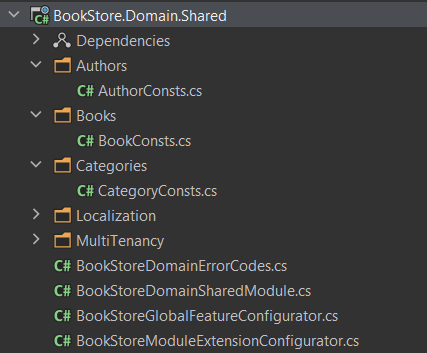
- AuthorConsts.cs
namespace BookStore.Authors
{
public class AuthorConsts
{
public const int MaxNameLength = 128;
public const int MaxShortBioLength = 256;
}
}
- BookConsts.cs
namespace BookStore.Books
{
public class BookConsts
{
public const int MaxNameLength = 128;
}
}
- CategoryConsts.cs
namespace BookStore.Categories
{
public class CategoryConsts
{
public const int MaxNameLength = 64;
}
}
In these classes, we've defined max text length for our entity properties that we will use in the Database Integration section to specify limits for our properties. (E.g. varchar(128) for BookName)
Step 3 - (Database Integration)
After defining our entities, we can configure them for the database integration.
Open the BookStoreDbContext class in the BookStore.EntityFrameworkCore project and update the following code blocks.
namespace BookStore.EntityFrameworkCore
{
[ReplaceDbContext(typeof(IIdentityDbContext))]
[ReplaceDbContext(typeof(ITenantManagementDbContext))]
[ConnectionStringName("Default")]
public class BookStoreDbContext :
AbpDbContext<BookStoreDbContext>,
IIdentityDbContext,
ITenantManagementDbContext
{
//...
//DbSet properties for our Aggregate Roots
public DbSet<Author> Authors { get; set; }
public DbSet<Book> Books { get; set; }
public DbSet<Category> Categories { get; set; }
//NOTE: We don't need to add DbSet<BookCategory>, because we will be query it via using the Book entity
// public DbSet<BookCategory> BookCategories { get; set; }
//...
protected override void OnModelCreating(ModelBuilder builder)
{
//...
/* Configure your own tables/entities inside here */
builder.Entity<Author>(b =>
{
b.ToTable(BookStoreConsts.DbTablePrefix + "Authors", BookStoreConsts.DbSchema);
b.ConfigureByConvention();
b.Property(x => x.Name)
.HasMaxLength(AuthorConsts.MaxNameLength)
.IsRequired();
b.Property(x => x.ShortBio)
.HasMaxLength(AuthorConsts.MaxShortBioLength)
.IsRequired();
});
builder.Entity<Book>(b =>
{
b.ToTable(BookStoreConsts.DbTablePrefix + "Books", BookStoreConsts.DbSchema);
b.ConfigureByConvention();
b.Property(x => x.Name)
.HasMaxLength(BookConsts.MaxNameLength)
.IsRequired();
//one-to-many relationship with Author table
b.HasOne<Author>().WithMany().HasForeignKey(x => x.AuthorId).IsRequired();
//many-to-many relationship with Category table => BookCategories
b.HasMany(x => x.Categories).WithOne().HasForeignKey(x => x.BookId).IsRequired();
});
builder.Entity<Category>(b =>
{
b.ToTable(BookStoreConsts.DbTablePrefix + "Categories", BookStoreConsts.DbSchema);
b.ConfigureByConvention();
b.Property(x => x.Name)
.HasMaxLength(CategoryConsts.MaxNameLength)
.IsRequired();
});
builder.Entity<BookCategory>(b =>
{
b.ToTable(BookStoreConsts.DbTablePrefix + "BookCategories", BookStoreConsts.DbSchema);
b.ConfigureByConvention();
//define composite key
b.HasKey(x => new { x.BookId, x.CategoryId });
//many-to-many configuration
b.HasOne<Book>().WithMany(x => x.Categories).HasForeignKey(x => x.BookId).IsRequired();
b.HasOne<Category>().WithMany().HasForeignKey(x => x.CategoryId).IsRequired();
b.HasIndex(x => new { x.BookId, x.CategoryId });
});
}
}
}
In this class, we've defined the DbSet properties for our Aggregate Roots (Book, Author and Category). Notice, we didn't define the DbSet for the
BookCategoryclass (our join table/entity). Because, theBookaggregate is responsible for managing it via sub-collection.After that, we can use the FluentAPI to configure our tables in the
OnModelCreatingmethod of this class.
builder.Entity<Book>(b =>
{
//...
//one-to-many relationship with Author table
b.HasOne<Author>().WithMany().HasForeignKey(x => x.AuthorId).IsRequired();
//many-to-many relationship with Category table => BookCategories
b.HasMany(x => x.Categories).WithOne().HasForeignKey(x => x.BookId).IsRequired();
});
Here, we have provided the one-to-many relationship between the Book and the Author in the above code-block.
builder.Entity<BookCategory>(b =>
{
//...
//define composite key
b.HasKey(x => new { x.BookId, x.CategoryId });
//many-to-many configuration
b.HasOne<Book>().WithMany(x => x.Categories).HasForeignKey(x => x.BookId).IsRequired();
b.HasOne<Category>().WithMany().HasForeignKey(x => x.CategoryId).IsRequired();
b.HasIndex(x => new { x.BookId, x.CategoryId });
});
Here, firstly we've defined the composite key for our BookCategory entity. BookId and CategoryId are together as composite keys for the BookCategory table. Then we've configured the many-to-many relationship between the Book and the Category tables like in the above code-block.
Implementing the IBookRepository Interface
After making the relevant configurations for the database integration, we can now implement the IBookRepository interface. To do this, create a folder named Books in the BookStore.EntityFrameworkCore project and inside of this folder, create a class named EfCoreBookRepository and update this class with the following code:
using System;
using System.Collections.Generic;
using System.Linq;
using System.Linq.Dynamic.Core;
using System.Threading;
using System.Threading.Tasks;
using BookStore.Authors;
using BookStore.Categories;
using BookStore.EntityFrameworkCore;
using Microsoft.EntityFrameworkCore;
using Volo.Abp.Domain.Repositories.EntityFrameworkCore;
using Volo.Abp.EntityFrameworkCore;
namespace BookStore.Books
{
public class EfCoreBookRepository : EfCoreRepository<BookStoreDbContext, Book, Guid>, IBookRepository
{
public EfCoreBookRepository(IDbContextProvider<BookStoreDbContext> dbContextProvider) : base(dbContextProvider)
{
}
public async Task<List<BookWithDetails>> GetListAsync(
string sorting,
int skipCount,
int maxResultCount,
CancellationToken cancellationToken = default
)
{
var query = await ApplyFilterAsync();
return await query
.OrderBy(!string.IsNullOrWhiteSpace(sorting) ? sorting : nameof(Book.Name))
.PageBy(skipCount, maxResultCount)
.ToListAsync(GetCancellationToken(cancellationToken));
}
public async Task<BookWithDetails> GetAsync(Guid id, CancellationToken cancellationToken = default)
{
var query = await ApplyFilterAsync();
return await query
.Where(x => x.Id == id)
.FirstOrDefaultAsync(GetCancellationToken(cancellationToken));
}
private async Task<IQueryable<BookWithDetails>> ApplyFilterAsync()
{
var dbContext = await GetDbContextAsync();
return (await GetDbSetAsync())
.Include(x => x.Categories)
.Join(dbContext.Set<Author>(), book => book.AuthorId, author => author.Id,
(book, author) => new {book, author})
.Select(x => new BookWithDetails
{
Id = x.book.Id,
Name = x.book.Name,
Price = x.book.Price,
PublishDate = x.book.PublishDate,
CreationTime = x.book.CreationTime,
AuthorName = x.author.Name,
CategoryNames = (from bookCategories in x.book.Categories
join category in dbContext.Set<Category>() on bookCategories.CategoryId equals category.Id
select category.Name).ToArray()
});
}
public override Task<IQueryable<Book>> WithDetailsAsync()
{
return base.WithDetailsAsync(x => x.Categories);
}
}
}
- Here, we've implemented our custom repository methods and returned the book with details (author name and categories).
Step 4 - (Database Migration)
We've integrated our entities with the database in the previous step, now we can create a new database migration and apply it to the database. So let's do that.
Open the
BookStore.EntityFrameworkCoreproject in the terminal. And create a new database migration by using the following command:
dotnet ef migrations add <Migration_Name>
- Then, run the
BookStore.DbMigratorapplication to create the database.
Step 5 - (Create Application Services)
- Let's start with defining our DTOs and application service interfaces in the
BookStore.Application.Contractslayer. We can create a folder-structure like in the image below:
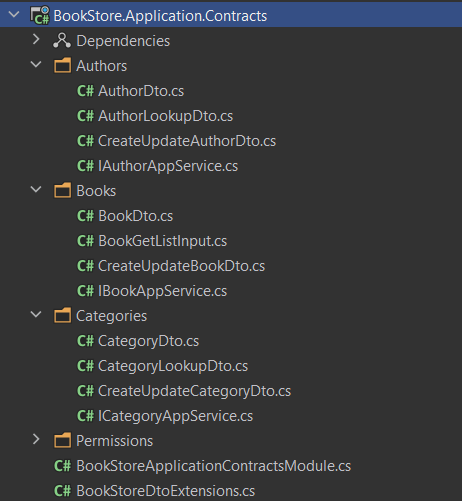
We can use the
CrudAppServicebase class of the ABP Framework to create application services to Get, Create, Update and Delete authors and categories.AuthorDto.cs
using System;
using Volo.Abp.Application.Dtos;
namespace BookStore.Authors
{
public class AuthorDto : EntityDto<Guid>
{
public string Name { get; set; }
public DateTime BirthDate { get; set; }
public string ShortBio { get; set; }
}
}
- AuthorLookupDto.cs
using System;
using Volo.Abp.Application.Dtos;
namespace BookStore.Authors
{
public class AuthorLookupDto : EntityDto<Guid>
{
public string Name { get; set; }
}
}
We will use this DTO class as output DTO to get all the authors and list them in a select box in the book creation model. (Like in the image below.)
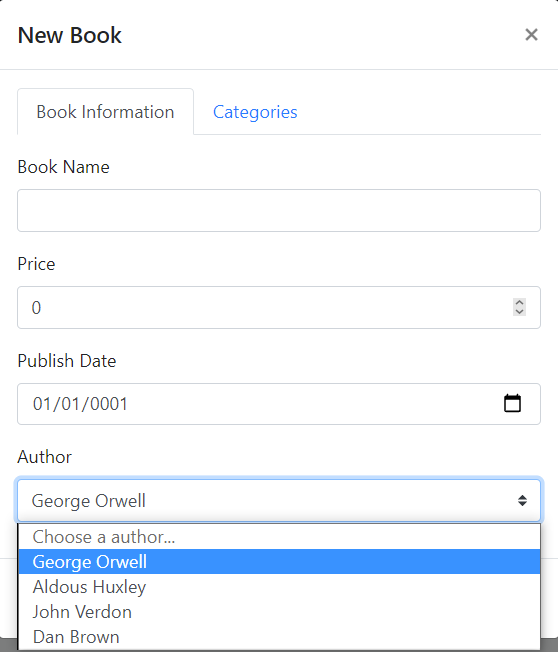
- CreateUpdateAuthorDto.cs
using System;
namespace BookStore.Authors
{
public class CreateUpdateAuthorDto
{
public string Name { get; set; }
public DateTime BirthDate { get; set; }
public string ShortBio { get; set; }
}
}
- IAuthorAppService.cs
using System;
using Volo.Abp.Application.Dtos;
using Volo.Abp.Application.Services;
namespace BookStore.Authors
{
public interface IAuthorAppService :
ICrudAppService<AuthorDto, Guid, PagedAndSortedResultRequestDto, CreateUpdateAuthorDto, CreateUpdateAuthorDto>
{
}
}
- BookDto.cs
using System;
using Volo.Abp.Application.Dtos;
namespace BookStore.Books
{
public class BookDto : EntityDto<Guid>
{
public string AuthorName { get; set; }
public string Name { get; set; }
public DateTime PublishDate { get; set; }
public float Price { get; set; }
public string[] CategoryNames { get; set; }
}
}
When listing the Book/Books we will retrieve them with all their details (author name and category names).
- BookGetListInput.cs
using Volo.Abp.Application.Dtos;
namespace BookStore.Books
{
public class BookGetListInput : PagedAndSortedResultRequestDto
{
}
}
- CreateUpdateBookDto.cs
using System;
namespace BookStore.Books
{
public class CreateUpdateBookDto
{
public Guid AuthorId { get; set; }
public string Name { get; set; }
public DateTime PublishDate { get; set; }
public float Price { get; set; }
public string[] CategoryNames { get; set; }
}
}
To create or update a book we will use this input DTO.
- IBookAppService.cs
using System;
using System.Threading.Tasks;
using BookStore.Authors;
using BookStore.Categories;
using Volo.Abp.Application.Dtos;
using Volo.Abp.Application.Services;
namespace BookStore.Books
{
public interface IBookAppService : IApplicationService
{
Task<PagedResultDto<BookDto>> GetListAsync(BookGetListInput input);
Task<BookDto> GetAsync(Guid id);
Task CreateAsync(CreateUpdateBookDto input);
Task UpdateAsync(Guid id, CreateUpdateBookDto input);
Task DeleteAsync(Guid id);
Task<ListResultDto<AuthorLookupDto>> GetAuthorLookupAsync();
Task<ListResultDto<CategoryLookupDto>> GetCategoryLookupAsync();
}
}
We will create custom application service method for managing Books instead of using the
CrudAppService's methods.Also we will create two additional methods and they are
GetAuthorLookupAsyncandGetCategoryLookupAsync. We will use these two methods to retrieve all the authors and categories without pagination and list them as a select box item in create/update modals for the Book page.
(You can see the usage of these two methods in the gif below.)

- CategoryDto.cs
using System;
using Volo.Abp.Application.Dtos;
namespace BookStore.Categories
{
public class CategoryDto : EntityDto<Guid>
{
public string Name { get; set; }
}
}
- CategoryLookupDto.cs
using System;
using Volo.Abp.Application.Dtos;
namespace BookStore.Categories
{
public class CategoryLookupDto : EntityDto<Guid>
{
public string Name { get; set; }
}
}
We will use this DTO class as an output DTO to get all categories without pagination and list them in a select box in the book create/update modals.
- CreateUpdateCategoryDto.cs
namespace BookStore.Categories
{
public class CreateUpdateCategoryDto
{
public string Name { get; set; }
}
}
- ICategoryAppService.cs
using System;
using Volo.Abp.Application.Dtos;
using Volo.Abp.Application.Services;
namespace BookStore.Categories
{
public interface ICategoryAppService :
ICrudAppService<CategoryDto, Guid, PagedAndSortedResultRequestDto, CreateUpdateCategoryDto, CreateUpdateCategoryDto>
{
}
}
After creating the DTOs and application service interfaces, now we can define the implementation of those interfaces. So, we can create a folder-structure like in the image below for the BookStore.Application layer. Open the application service classes and add the following codes to each of these classes.

- AuthorAppService.cs
using System;
using Volo.Abp.Application.Dtos;
using Volo.Abp.Application.Services;
using Volo.Abp.Domain.Repositories;
namespace BookStore.Authors
{
public class AuthorAppService :
CrudAppService<Author, AuthorDto, Guid, PagedAndSortedResultRequestDto, CreateUpdateAuthorDto, CreateUpdateAuthorDto>,
IAuthorAppService
{
public AuthorAppService(IRepository<Author, Guid> repository) : base(repository)
{
}
}
}
- CategoryAppService.cs
using System;
using Volo.Abp.Application.Dtos;
using Volo.Abp.Application.Services;
using Volo.Abp.Domain.Repositories;
namespace BookStore.Categories
{
public class CategoryAppService :
CrudAppService<Category, CategoryDto, Guid, PagedAndSortedResultRequestDto, CreateUpdateCategoryDto, CreateUpdateCategoryDto>,
ICategoryAppService
{
public CategoryAppService(IRepository<Category, Guid> repository) : base(repository)
{
}
}
}
Thanks to the CrudAppService, we don't need to manually implement the crud methods for AuthorAppService and CategoryAppService.
- BookAppService.cs
using System;
using System.Collections.Generic;
using System.Threading.Tasks;
using BookStore.Authors;
using BookStore.Categories;
using Volo.Abp.Application.Dtos;
using Volo.Abp.Domain.Repositories;
namespace BookStore.Books
{
public class BookAppService : BookStoreAppService, IBookAppService
{
private readonly IBookRepository _bookRepository;
private readonly BookManager _bookManager;
private readonly IRepository<Author, Guid> _authorRepository;
private readonly IRepository<Category, Guid> _categoryRepository;
public BookAppService(
IBookRepository bookRepository,
BookManager bookManager,
IRepository<Author, Guid> authorRepository,
IRepository<Category, Guid> categoryRepository
)
{
_bookRepository = bookRepository;
_bookManager = bookManager;
_authorRepository = authorRepository;
_categoryRepository = categoryRepository;
}
public async Task<PagedResultDto<BookDto>> GetListAsync(BookGetListInput input)
{
var books = await _bookRepository.GetListAsync(input.Sorting, input.SkipCount, input.MaxResultCount);
var totalCount = await _bookRepository.CountAsync();
return new PagedResultDto<BookDto>(totalCount, ObjectMapper.Map<List<BookWithDetails>, List<BookDto>>(books));
}
public async Task<BookDto> GetAsync(Guid id)
{
var book = await _bookRepository.GetAsync(id);
return ObjectMapper.Map<BookWithDetails, BookDto>(book);
}
public async Task CreateAsync(CreateUpdateBookDto input)
{
await _bookManager.CreateAsync(
input.AuthorId,
input.Name,
input.PublishDate,
input.Price,
input.CategoryNames
);
}
public async Task UpdateAsync(Guid id, CreateUpdateBookDto input)
{
var book = await _bookRepository.GetAsync(id, includeDetails: true); //return type is: Book (not BookWithDetails) Because, we don't need author name
await _bookManager.UpdateAsync(
book,
input.AuthorId,
input.Name,
input.PublishDate,
input.Price,
input.CategoryNames
);
}
public async Task DeleteAsync(Guid id)
{
await _bookRepository.DeleteAsync(id);
}
public async Task<ListResultDto<AuthorLookupDto>> GetAuthorLookupAsync()
{
var authors = await _authorRepository.GetListAsync();
return new ListResultDto<AuthorLookupDto>(
ObjectMapper.Map<List<Author>, List<AuthorLookupDto>>(authors)
);
}
public async Task<ListResultDto<CategoryLookupDto>> GetCategoryLookupAsync()
{
var categories = await _categoryRepository.GetListAsync();
return new ListResultDto<CategoryLookupDto>(
ObjectMapper.Map<List<Category>, List<CategoryLookupDto>>(categories)
);
}
}
}
As you can notice here, we've used our Domain Service class named
BookManagerin the CreateAsync and UpdateAsync methods. (Defined them in step 1)As you may remember, in these methods, new categories are added to the book or removed from the sub-collection (Categories (
BookCategory)) according to the relevant category names.After implementing the application services, we need to define the mappings for our services to work. So open the
BookStoreApplicationAutoMapperProfileclass and update it with the following code:
using AutoMapper;
using BookStore.Authors;
using BookStore.Books;
using BookStore.Categories;
namespace BookStore
{
public class BookStoreApplicationAutoMapperProfile : Profile
{
public BookStoreApplicationAutoMapperProfile()
{
CreateMap<Category, CategoryDto>();
CreateMap<Category, CategoryLookupDto>();
CreateMap<CreateUpdateCategoryDto, Category>();
CreateMap<Author, AuthorDto>();
CreateMap<Author, AuthorLookupDto>();
CreateMap<CreateUpdateAuthorDto, Author>();
CreateMap<BookWithDetails, BookDto>();
}
}
}
Step 6 - (UI)
The only thing we need to do is, by using the application service methods that we've defined in the previous step to create the UI.
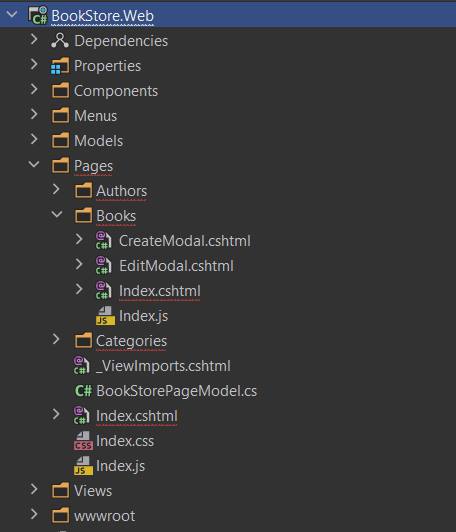
To keep the article shorter, I'll just show you how to create the Book page (with Create/Edit modals). If you want to implement it to other pages, you can access the source code of the application at https://github.com/EngincanV/ABP-Many-to-Many-Relationship-Demo and copy-paste the relevant code-blocks to your application.
Book Page
Create a razor page named Index.cshtml under the Pages/Books folder of the
BookStore.Webproject and paste the following code to that page.Index.cshtml
@page
@model BookStore.Web.Pages.Books.Index
@section scripts
{
<abp-script src="/Pages/Books/Index.js" />
}
<abp-card>
<abp-card-header>
<abp-row>
<abp-column size-md="_6">
<abp-card-title>Books</abp-card-title>
</abp-column>
<abp-column size-md="_6" class="text-right">
<abp-button id="NewBookButton"
text="New Book"
icon="plus"
button-type="Primary"/>
</abp-column>
</abp-row>
</abp-card-header>
<abp-card-body>
<abp-table striped-rows="true" id="BooksTable"></abp-table>
</abp-card-body>
</abp-card>
In here we've added a New Book button and a table with an id named "BooksTable". We'll create an Index.js file and by using datatable.js we will fill the table with our records.
- Index.js
$(function () {
var createModal = new abp.ModalManager(abp.appPath + 'Books/CreateModal');
var editModal = new abp.ModalManager(abp.appPath + 'Books/EditModal');
var bookService = bookStore.books.book;
var dataTable = $('#BooksTable').DataTable(
abp.libs.datatables.normalizeConfiguration({
serverSide: true,
paging: true,
order: [[1, "asc"]],
searching: false,
scrollX: true,
ajax: abp.libs.datatables.createAjax(bookService.getList),
columnDefs: [
{
title: 'Actions',
rowAction: {
items:
[
{
text: 'Edit',
action: function (data) {
editModal.open({ id: data.record.id });
}
},
{
text: 'Delete',
confirmMessage: function (data) {
return "Are you sure to delete the book '" + data.record.name +"'?";
},
action: function (data) {
bookService
.delete(data.record.id)
.then(function() {
abp.notify.info("Successfully deleted!");
dataTable.ajax.reload();
});
}
}
]
}
},
{
title: 'Name',
data: "name"
},
{
title: 'Publish Date',
data: "publishDate",
render: function (data) {
return luxon
.DateTime
.fromISO(data, {
locale: abp.localization.currentCulture.name
}).toLocaleString();
}
},
{
title: 'Author Name',
data: "authorName"
},
{
title: 'Price',
data: "price"
},
{
title: 'Categories',
data: "categoryNames",
render: function (data) {
return data.join(", ");
}
}
]
})
);
createModal.onResult(function () {
dataTable.ajax.reload();
});
editModal.onResult(function () {
dataTable.ajax.reload();
});
$('#NewBookButton').click(function (e) {
e.preventDefault();
createModal.open();
});
});
abp.libs.datatables.normalizeConfigurationis a helper function defined by the ABP Framework. It simplifies the Datatables configuration by providing conventional default values for missing options.
Let's examine what we've done in the
Index.jsfile.Firstly, we've defined our
createModalandeditModalmodals by using the ABP Modals. Then, we've created the DataTable and fetched our books by using the dynamic JavaScript proxy function (bookStore.books.book.getList) (It sends a request to the GetListAsync method that we've defined in theBookAppServiceunder the hook) and we've shown them in the table with an id named "BooksTable".Now let's run the application and navigate to the /Books route to see how our Book page looks.

We need to see a page similar to the image above. Our app is working properly, we can continue developing.
If you are stuck in any point, you can examine the source codes.
Model Classes and Mapping Configurations
Create a folder named Models and add a class named CategoryViewModel inside of it. We will use this view modal class to determine which categories are selected or not in our Create/Edit modals.
- CategoryViewModel.cs
using System;
using System.ComponentModel.DataAnnotations;
using Microsoft.AspNetCore.Mvc;
namespace BookStore.Web.Models
{
public class CategoryViewModel
{
[HiddenInput]
public Guid Id { get; set; }
public bool IsSelected { get; set; }
[Required]
[HiddenInput]
public string Name { get; set; }
}
}
Then, we can open the BookStoreWebAutoMapperProfile class and define the required mappings as follows:
using AutoMapper;
using BookStore.Authors;
using BookStore.Books;
using BookStore.Categories;
using BookStore.Web.Models;
using BookStore.Web.Pages.Books;
using Volo.Abp.AutoMapper;
namespace BookStore.Web
{
public class BookStoreWebAutoMapperProfile : Profile
{
public BookStoreWebAutoMapperProfile()
{
CreateMap<CategoryLookupDto, CategoryViewModel>()
.Ignore(x => x.IsSelected);
CreateMap<BookDto, CreateUpdateBookDto>();
CreateMap<AuthorDto, CreateUpdateAuthorDto>();
CreateMap<CategoryDto, CreateUpdateCategoryDto>();
}
}
}
Create/Edit Modals
After creating our index page for Books and configuring mappings, let's continue with creating the Create/Edit modals for Books.
Create a razor page named CreateModal.cshtml (and CreateModal.cshtml.cs).
- CreateModal.cshtml
@page
@using Volo.Abp.AspNetCore.Mvc.UI.Bootstrap.TagHelpers.Modal
@model BookStore.Web.Pages.Books.CreateModal
@{
Layout = null;
}
<form method="post" id="CreateBookModal" asp-page="/Books/CreateModal">
<abp-modal>
<abp-modal-header title="New Book"></abp-modal-header>
<abp-modal-body>
<abp-tabs name="create-book-modal-tabs">
<abp-tab title="Book Information" class="mt-3">
<div id="book-information-wrapper" class="mt-3">
<abp-input asp-for="Book.Name" label="Book Name"/>
<abp-input asp-for="Book.Price" label="Price" type="number"/>
<abp-input asp-for="Book.PublishDate" type="date" label="Publish Date"/>
<abp-select asp-for="Book.AuthorId" asp-items="@Model.AuthorList" label="Author">
<option value="" disabled="disabled">Choose a author...</option>
</abp-select>
</div>
</abp-tab>
<abp-tab title="Categories">
<div id="category-list-wrapper" class="mt-3">
@for (var i = 0; i < Model.Categories.Count; i++)
{
var category = Model.Categories[i];
<abp-input abp-id-name="@Model.Categories[i].IsSelected" asp-for="@category.IsSelected" label="@category.Name"/>
<input abp-id-name="@Model.Categories[i].Name" asp-for="@category.Name" />
}
</div>
</abp-tab>
</abp-tabs>
</abp-modal-body>
<abp-modal-footer buttons="@(AbpModalButtons.Cancel|AbpModalButtons.Save)"></abp-modal-footer>
</abp-modal>
</form>
- CreateModal.cshtml.cs
using System.Collections.Generic;
using System.Linq;
using System.Threading.Tasks;
using BookStore.Books;
using BookStore.Categories;
using BookStore.Web.Models;
using Microsoft.AspNetCore.Mvc;
using Microsoft.AspNetCore.Mvc.Rendering;
namespace BookStore.Web.Pages.Books
{
public class CreateModal : BookStorePageModel
{
[BindProperty]
public CreateUpdateBookDto Book { get; set; }
[BindProperty]
public List<CategoryViewModel> Categories { get; set; }
public List<SelectListItem> AuthorList { get; set; }
private readonly IBookAppService _bookAppService;
public CreateModal(IBookAppService bookAppService)
{
_bookAppService = bookAppService;
}
public async Task OnGetAsync()
{
Book = new CreateUpdateBookDto();
//Get all authors and fill the select list
var authorLookup = await _bookAppService.GetAuthorLookupAsync();
AuthorList = authorLookup.Items
.Select(x => new SelectListItem(x.Name, x.Id.ToString()))
.ToList();
//Get all categories
var categoryLookupDto = await _bookAppService.GetCategoryLookupAsync();
Categories = ObjectMapper.Map<List<CategoryLookupDto>, List<CategoryViewModel>>(categoryLookupDto.Items.ToList());
}
public async Task<IActionResult> OnPostAsync()
{
ValidateModel();
var selectedCategories = Categories.Where(x => x.IsSelected).ToList();
if (selectedCategories.Any())
{
var categoryNames = selectedCategories.Select(x => x.Name).ToArray();
Book.CategoryNames = categoryNames;
}
await _bookAppService.CreateAsync(Book);
return NoContent();
}
}
}
Here, we've got all categories and authors inside of the OnGetAsync method. And use them inside of the create modal to list them so the user can choose when creating a new book.

- When the user submits the form, the
OnPostAsyncmethod runs. Inside of this method, we get the selected categories and pass them into the CategoryNames array of the Book object and call theIBookAppService.CreateAsyncmethod to create a new book.
Create a razor page named EditModal.cshtml (and EditModal.cshtml.cs).
- EditModal.cshtml
@page
@using Volo.Abp.AspNetCore.Mvc.UI.Bootstrap.TagHelpers.Modal
@model BookStore.Web.Pages.Books.EditModal
@{
Layout = null;
}
<form method="post" id="EditBookModal" asp-page="/Books/EditModal">
<abp-modal>
<abp-modal-header title="Update"></abp-modal-header>
<abp-modal-body>
<abp-tabs name="edit-book-modal-tabs">
<abp-tab title="Book Information" class="mt-3">
<div id="book-information-wrapper" class="mt-3">
<abp-input asp-for="Id" />
<abp-input asp-for="EditingBook.Name" label="Book Name"/>
<abp-input asp-for="EditingBook.Price" label="Price" type="number"/>
<abp-input asp-for="EditingBook.PublishDate" type="date" label="Publish Date"/>
<abp-select asp-for="EditingBook.AuthorId" asp-items="@Model.AuthorList" label="Author">
<option value="" disabled="disabled">Choose a author...</option>
</abp-select>
</div>
</abp-tab>
<abp-tab title="Categories">
<div id="category-list-wrapper" class="mt-3">
@for (var i = 0; i < Model.Categories.Count; i++)
{
var category = Model.Categories[i];
<abp-input abp-id-name="@Model.Categories[i].IsSelected" asp-for="@category.IsSelected" label="@category.Name"/>
<input abp-id-name="@Model.Categories[i].Name" asp-for="@category.Name" />
}
</div>
</abp-tab>
</abp-tabs>
</abp-modal-body>
<abp-modal-footer buttons="@(AbpModalButtons.Cancel|AbpModalButtons.Save)"></abp-modal-footer>
</abp-modal>
</form>
- EditModal.cshtml.cs
using System;
using System.Collections.Generic;
using System.Linq;
using System.Threading.Tasks;
using BookStore.Books;
using BookStore.Categories;
using BookStore.Web.Models;
using Microsoft.AspNetCore.Mvc;
using Microsoft.AspNetCore.Mvc.Rendering;
namespace BookStore.Web.Pages.Books
{
public class EditModal : BookStorePageModel
{
[HiddenInput]
[BindProperty(SupportsGet = true)]
public Guid Id { get; set; }
[BindProperty]
public CreateUpdateBookDto EditingBook { get; set; }
[BindProperty]
public List<CategoryViewModel> Categories { get; set; }
public List<SelectListItem> AuthorList { get; set; }
private readonly IBookAppService _bookAppService;
public EditModal(IBookAppService bookAppService)
{
_bookAppService = bookAppService;
}
public async Task OnGetAsync()
{
var bookDto = await _bookAppService.GetAsync(Id);
EditingBook = ObjectMapper.Map<BookDto, CreateUpdateBookDto>(bookDto);
//get all authors
var authorLookup = await _bookAppService.GetAuthorLookupAsync();
AuthorList = authorLookup.Items
.Select(x => new SelectListItem(x.Name, x.Id.ToString()))
.ToList();
//get all categories
var categoryLookupDto = await _bookAppService.GetCategoryLookupAsync();
Categories = ObjectMapper.Map<List<CategoryLookupDto>, List<CategoryViewModel>>(categoryLookupDto.Items.ToList());
//mark as Selected for Categories in the book
if (EditingBook.CategoryNames != null && EditingBook.CategoryNames.Any())
{
Categories
.Where(x => EditingBook.CategoryNames.Contains(x.Name))
.ToList()
.ForEach(x => x.IsSelected = true);
}
}
public async Task<IActionResult> OnPostAsync()
{
ValidateModel();
var selectedCategories = Categories.Where(x => x.IsSelected).ToList();
if (selectedCategories.Any())
{
var categoryNames = selectedCategories.Select(x => x.Name).ToArray();
EditingBook.CategoryNames = categoryNames;
}
await _bookAppService.UpdateAsync(Id, EditingBook);
return NoContent();
}
}
}
As in the
CreateModal.cshtml.cs, we've got all categories and authors inside of theOnGetAsyncmethod. And also we get the book by id and mark the selected categories properties' asIsSelected = true.When the user updates the inputs and submits the form, the
OnPostAsyncmethod runs. Inside of this method, we get the selected categories and pass them into the CategoryNames array of the Book object and call theIBookAppService.UpdateAsyncmethod to update the book.
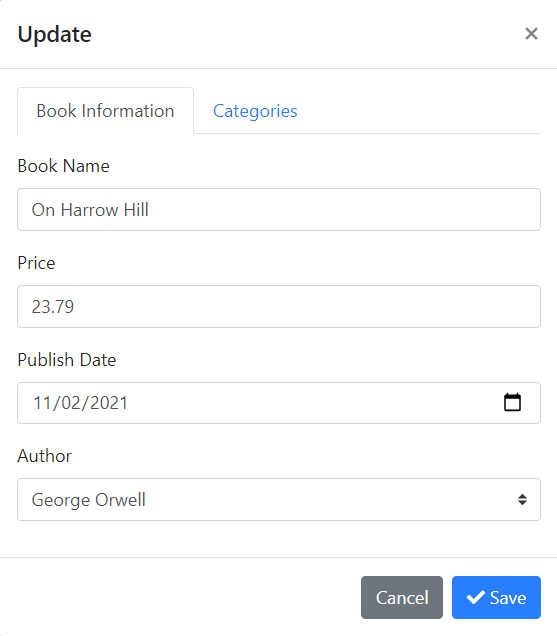
🛠 Liked this post? I now share all my content on Substack — real-world .NET, AI, and scalable software design.
👉 Subscribe here → engincanveske.substack.com
🎥 Also, check out my YouTube channel for hands-on demos and deep dives: https://www.youtube.com/@engincanv
Conclusion
In this article, I've tried to explain how to create a many-to-many relationship by using the ABP framework. (by following DDD principles)
Thanks for reading this article, I hope it was helpful.


























































Comments
Serdar Genc 213 weeks ago
good article. thanks EngincanV.
Engincan Veske 213 weeks ago
Thanks :)
274845698@qq.com 213 weeks ago
Well done!Tks
Engincan Veske 213 weeks ago
Thanks :)
romain.lazaud@gmail.com 213 weeks ago
Thanks ! Is there an equivalent with MongoDb implementation ?
Engincan Veske 213 weeks ago
Thanks :) Actually, you just need to change the third step (Database Integration step). Make the following changes on your db context class:
Ex: DbSet<Author> Authors { get; set; } => IMongoCollection<Author> Authors { get; set; }
And if you want to define column name, max length etc. do it in the CreateModel method of your db context class and lastly implement the IBookRepository interface.
Alper Ebiçoğlu 206 weeks ago
If you are planning to implement a relationship on MongoDB probably you are on the wrong way. Whether switch to a relational database or play MongoDB with its rules :)
Jack Lavallet 211 weeks ago
Hi Engincan, I have a quick question about your choice of using the Category Names instead of Category IDs for managing the many to many relationships. I will need to show more fields from my dependent entity. Can you think of anything I should look out for if I elect to change the string[] categoryNames to Guid[] categoryIds and then depend on the lookups to get the data to display?
Engincan Veske 211 weeks ago
Hi @jlavallet12, you can use the
categoryIdsinstead ofcategoryNames. I want to share the steps to demonstrate what would I do in this case. In theGetListAsyncmethod of your application service you can get allcategoryIdsin the fetched books in a list and use a repository method (ICategoryRepository) to get all categories by specifiedcategoryIds.(like below)
List<Category> categories = await _categoryRepository.GetDetailsByIds(categoryIds);In your BookDto class, make the following changes:
public string[] CategoryNames { get; set; }=>public List<CategoryDto> Categories { get; set; }and map with the new dto class.
Rwing 211 weeks ago
Nice article!!!
Engincan Veske 211 weeks ago
Thanks :)
zaedan 210 weeks ago
Hi,
Wonderfull tutorial but because I don't have .NET6, I build a new solution and use your code in a abp angular solution. The problem is in EfCoreBookRepository, I have to add AsSingleQuery in method
because I have the error :
Any idea why ? Regards
Johan Sánchez 206 weeks ago
Hello is planning add this feature to abp suite?
Alper Ebiçoğlu 206 weeks ago
Not yet
stefan.gabor1@gmail.com 184 weeks ago
This is great to show a simple N:N relationship, however, it will not work with large sets of data.
Engincan Veske 184 weeks ago
Thanks. I agree with you, it needs optimization for large sets of data.
qyhzcs@gmail.com 184 weeks ago
thanks EngincanV.
Engincan Veske 184 weeks ago
Thanks :)
dat5574 181 weeks ago
Hi, Great article on a topic I'm trying to learn more about. I'm new to the framework and EF migrations so my question on the custom repository method you created that returns BookWithDetails...
private async Task<IQueryable<BookWithDetails>>ApplyFilterAsync() ...
Does EF migrations only look at classes the inherit from Entity then try to create a corresponding database table (i.e when you run the Add-Migration/Update-Database commands?
I noticed BookWithDetails.cs does not. IOW if you need to return a model class from your custom repository method that you don't wanted mapped to database it would just be a plain class if that makes sense?
Or maybe because it's an EF thing where if there is no DbSet defined in the BookStoreDbContext it won't get generated as table?
Thanks!
zubaidi 149 weeks ago
What was the reason for creating the BookWithDetails and not directly using the Book entity?